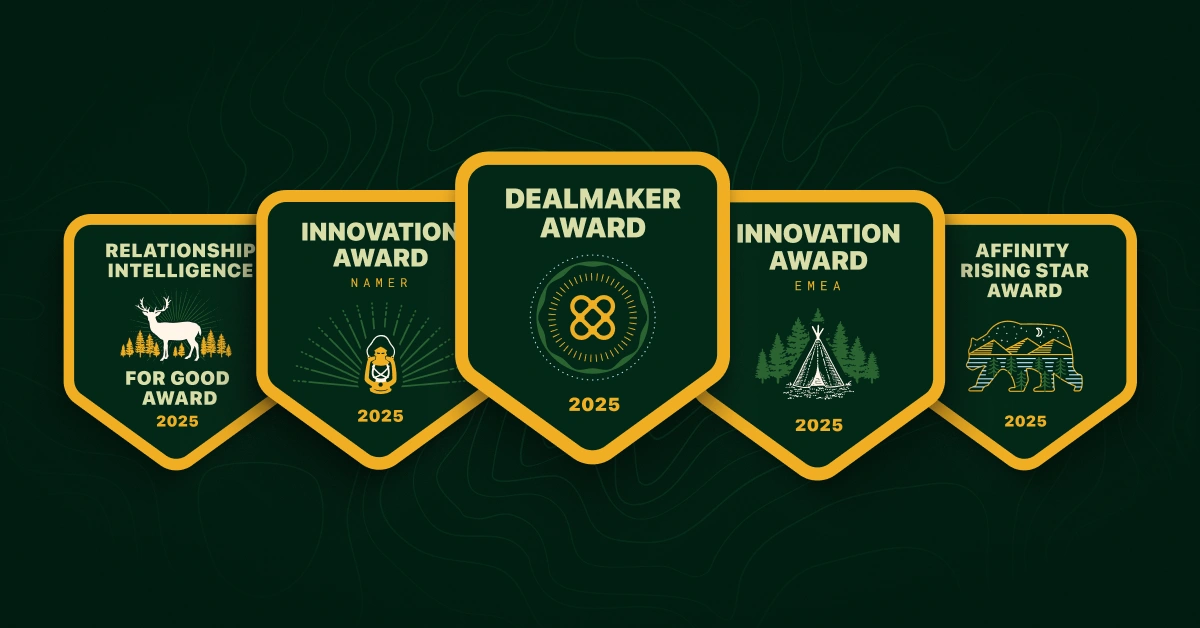Over the last 20 years, Europe’s technology landscape has transformed dramatically, evolving from a peripheral player into a significant contender on the global stage. Today, the region boasts some of the world’s most dynamic startup centers. European VC investment peaked in 2021 during the global venture surge, and while the market has corrected, the fundamentals remain strong: European VC has grown fivefold in the last decade, with European startups now claiming approximately 20% of global venture capital, up from just 5% 20 years ago.
In our 2025 European venture capital benchmark report, we analyzed Affinity platform data on more than 640 of our European VC customers across 27 countries (who we refer to as “All Firms”) versus a subset of those ranked as “Top Firms” by Dealroom’s VC Investor Ranking.
Overall deal volume may have decreased year-over-year, but this shift reveals a strategic evolution rather than a total market decline. Investors doubled down on companies with clearer paths to profitability and long-term growth. Our analysis shows how top-performing firms are adapting to thrive in this selective market. Here are five key trends shaping European venture capital in 2025.
{{report-202407="/rt-components"}}
Key takeaways
- European VC deal volume dropped 23% over the course of 2024, but top firms are strategically embracing selectivity over volume
- AI investments surged 24% in deal value, with life sciences following as a close second growth sector
- Outbound deal sourcing is rising as firms expand networks and leverage data-driven approaches
- Top European VCs are prioritizing portfolio support through targeted introductions and relationship-driven strategies
- Integrating AI tools across the deal cycle is essential for competitive advantage
Trend 1: The strategic shift to “value over volume”
European VCs are embracing radical selectivity, with top firms adding 42% fewer deals in Q4 2024 compared to the previous year. Rather than see this as a market contraction, it could also be looked at as a strategic evolution.
This shift was covered recently in our webinar with Lightstpeed and Salesforce Ventures, Market Consolidation: Navigating 2025’s Investment Landscape: "We're in the midst of a cycle shift… In times of uncertainty, there tends to be a flight to quality. People can’t necessarily understand all the different trend directions, but they can at least put their chips in a couple of bets that are going to turn out for sure," said Mercedes Bent, Partner at Lightspeed.
The selectivity reflects a deeper understanding of how venture returns work. Our data shows that Top Firms are applying stricter sourcing and diligence criteria, with a sharper focus on founder quality and growth potential. So, while deal volume decreases, the quality of investments—and potential returns—increases.
Trend 2: More selective, data-driven outbound
Outbound deal sourcing is surging across European VC, with all firms sending and receiving more emails year-over-year. Firms are getting more creative, reaching out to a broader range of founders in niche sectors and less saturated locations.
More significantly, 64% of firms are now using AI to accelerate company research, as technology and data reshape both investment and operational processes.
On this AI acceleration, Reanesh Kanaganayagam, Affinity’s Senior Product Marketing Manager, said: “We talk about that from an investment standpoint, but there's now an operations aspect to it as well, making data-driven approaches even more integral to venture investing.”
While Top Firms maintained relatively flat outreach, they're leveraging their established networks more strategically. In general, All Firms saw a higher, more consistent network growth throughout the year than top firms.
Trend 3: AI dominates investment and disrupts traditional signals
AI investments in Europe saw a remarkable 24% year-over-year increase in deal value, fundamentally reshaping the investment landscape. The surge and the unprecedented scale of AI’s impact have prompted industry leaders to question just how large the opportunity could become:
"If AI has attracted 100 million users in two months and is taking away the labor cost of a lot of these companies, then could the size of the prize be even bigger than one or 2 trillion?" asked Mercedes Bent.
Industry experts are recognizing that AI-enabled companies can achieve massive scale with minimal resources. Brian James Murphy from Salesforce Ventures observed, "Companies can build products with one person, essentially." Because of this reality, traditional metrics like headcount—which were once considered strong investment signals—are no longer as relevant in evaluating a company's potential.”
{{report-202411="/rt-components"}}
Trend 4: Portfolio support serves as competitive differentiation
In early 2024, Top Firms made more introductions quarter-over-quarter, with the sharpest increase in Q1 (+15%), even as their network growth slowed. Rather than using the introductions mainly to source new deals, these firms increasingly focused on supporting their portfolio companies, leveraging their extensive, established networks to connect founders with talent, customers, and vendors.
This approach contrasts with All Firms, who also increased introductions but continued to use them primarily to drive deal flow. The difference in both volume and intent underscores a broader shift: for top-performing firms, portfolio support has become a core differentiator, moving beyond traditional networking to deepen relationships and deliver tangible value to their existing investments.
Trend 5: Tech integration at every part of the deal cycle
Beyond just AI adoption, European VCs are integrating technology throughout their entire dealmaking process. From automated relationship intelligence to AI-powered market research, technology is becoming essential infrastructure rather than optional enhancement.
As Eric Emmons from MassMutual Ventures noted in our recent webinar, Data and network-powered sourcing, "Tools like ChatGPT have allowed a sourcing team to quickly understand the competitors in a market—something that used to take much longer with traditional desktop or interview-based diligence. The effort required for one person to get their arms around a market segment has gone down substantially."
Common use cases for tech integration include spotting early signals of product-market fit or accelerating company research and due diligence. During windows where there’s less volume at the top of the funnel, VCs use technology to sharpen their decision-making and stay competitive. With better data and automated insights, firms can evaluate more opportunities thoroughly, while maintaining lean teams and sharply-focused investment strategies.
{{report-202407="/rt-components"}}
How VC firms get ahead in 2025
To get ahead in 2025, European VC firms should lean into the market’s shift toward selectivity, focusing their efforts on conducting deeper diligence with a smaller pool of high-potential opportunities. Investing in robust data infrastructure and AI tools will allow teams to efficiently research and identify promising companies, enabling them to evaluate more opportunities without needing to deploy more capital.
Developing AI expertise across both investment and portfolio support functions is increasingly critical, as AI integration is now a source of competitive advantage across all sectors, not just in AI-focused startups.
Firms should also systematize their approach to portfolio support by adopting CRM technology, using their networks not just for sourcing deals but for actively creating value for portfolio companies through strategic connections to talent, customers, and vendors. Tools like the Affinity CRM empower firms to map and activate these relationships, turning network intelligence into a true competitive advantage.
Ultimately, technology adoption should be seen as a foundational investment. In a market where data-driven decision making is quickly becoming the norm, building these capabilities is essential for staying competitive and adapting to ongoing market changes.
How does your firm stack up?
To see how your firm’s dealmaking activities compare to other firms in the field, get your copy of the 2025 venture capital benchmark report: European edition. With exclusive insights and real data on hundreds of European firms, you’ll get:
- Performance benchmarks of industry leaders
- Characteristics that differentiate top firms
- Ways to adapt your strategies to get ahead this year
Building strong relationships and using data to guide your strategy are now essential for VCs looking to adapt and outperform in today’s market.
Use our benchmark tool to explore further how your deal-making activities stack up against top European VCs across network engagement, deal volume, and regional trends.
By investing in technologies like Affinity, the CRM purpose-built for venture capital, your firm can make smarter decisions and unlock the full value of your network.
{{request-demo-b="/rt-components"}}
European investment trends FAQ
What are some key investment trends for European VC in 2025? How have these trends evolved?
In 2025, European venture capital is seeing a continued "flight to quality," with investors focusing on companies that show strong paths to profitability and long-term growth, especially in sectors like AI and life sciences, which have seen increased deal value and helped drive a recovery in the exit market. Compared to previous years, the market has shifted from high deal volume to more selective investing, with greater emphasis on thorough diligence and data-driven sourcing as firms compete for the best opportunities.
What distinguishes top European VCs from other firms?
Top European VCs stand out by being much more selective, focusing on fewer but higher-quality deals, and applying stricter criteria around founder quality and growth potential. With established brands and proven track records, they can rely more on deep, established relationships and inbound deal flow, using data and technology to manage networks and support portfolio companies, rather than casting a wide net or aggressively expanding their contacts.
Which sectors are attracting the most VC interest in Europe this year?
AI and life sciences are the standout sectors attracting the most VC interest in Europe this year. Despite an overall decrease in deal volume across the market, AI and life sciences both saw a year-over-year increase in deal value. These two sectors not only outperformed others in terms of investment activity, but also played a key role in driving a recovery in the European exit market. This trend reflects a broader shift among investors toward companies with clearer paths to profitability in high-potential, innovation-driven industries


.webp)

.jpg)


.png)


.webp)
.webp)
